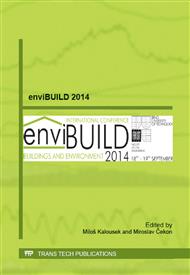p.146
p.150
p.154
p.158
p.162
p.167
p.171
p.175
p.183
Integration of Small Wind Energy Source for Optimization of Energy Efficiency in Residential Building
Abstract:
According to current European strategy and effort, an integration of renewable energy sources (RES) applying of new technologies should have of crucial importance, especially with contribution to the energy efficiency optimizing in buildings. Concurrently, energy performance and energy consumption of the all housing stock is one of the key indicators that represent the adequate utility value of those efforts. The paper focuses on the proposal concept integration of renewable energy for residential house in relation to assessment of the building thermal and energy performance. The proposed concept applying of wind turbines is presented for residential building in terms of standardized target periods. Finally, payback period calculation demonstrates a certain potential of applying small wind turbine as a renewable energy source in residential building of recently given target periods of current technical regulation.
Info:
Periodical:
Pages:
162-166
Citation:
Online since:
October 2014
Authors:
Price:
Сopyright:
© 2014 Trans Tech Publications Ltd. All Rights Reserved
Share:
Citation:


